The Australian Bureau of Statistics (ABS) has published the latest statistics on marriages and divorces in Australia. There are some interesting trends beginning to show up in an industry that, traditionally, has been laden with massive expectations.
One of life’s milestones is this societal institution called ‘marriage’. Even in these ‘modern times’, there is still significant pressure from family members for couples to get married and form a family sometime within their late 20s or early 30s.
For some, that happens like clockwork and their partnership is life-long. Others marry the person of their dreams, only to discover some years down the track that they have grown apart from each other and the best outcome for all involved is to separate and divorce.
These statistics help us to identify those trends and tell that story.
Do you need help to plan your wedding in Melbourne?
Trend 1: The number of marriages being conducted annually is decreasing
Over the past five (5) years, there has been a trend towards fewer couples getting married.
Prior to the pandemic of 2020, more than 110000 couples got married in Australia each year.
That reduced by almost 35000 quickly as a result of COVID in 2020. But, whilst the number of marriages recovered somewhat in 2021, it is far from being at the pre-COVID levels.
A possible reason for this is that in 2021 some couples were still waiting for some certainty and confidence about international borders being opened permanently, rather than wishing to go through the anguish and financial pain of rescheduling their wedding.
It will be interesting to see the statistics on marriages in Australia over the next five years – will the downward trend continue or will the number bounce back to pre-COVID levels?

Trend 2: The effect of COVID 19 on marriage numbers
Across Australia in 2020, there was a significant decrease in the number of marriages that took place. In fact, there were almost 35000 fewer marriages in 2020 than in 2019, before Covid hit.
Marriage plans were thrown into disarray for many couples. Lockdowns were announced at very short notice, sometimes, requiring planned weddings to be cancelled or rescheduled.
This caused great disruption to the couples getting married as well as their guests, who often had booked flights, accommodation and time off work to attend.
Clearly, it also negatively affected the numerous wedding suppliers – venues, caterers, florists, celebrants, cake-makers etc.
Unfortunately, some couples’ relationships did not survive the pressures of long lockdowns and some separated before they became married.

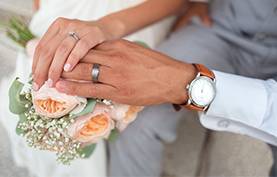

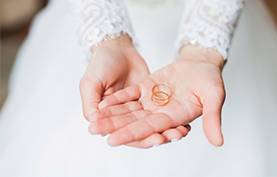
Trend 3: The typical life-stage of marriages for straight couples
Straight men marry at the age of approximately 30 years; straight women marry at the age of 27 years.
Those who separate do so after approximately 8½ years of marriage, when the man is 42 years old and the woman is 39 years old.
Straight couples who divorce will do so 12 years after they got married, when the man is 46 years old and the woman is 43 years old.

Trend 4: The Crude Divorce Rate (CDR) is steady
The Crude Divorce Rate is reasonably stable. It has remained at just over 2 divorces per 1000 people in the general population since 2011.
Do you need help to plan your wedding in Melbourne?
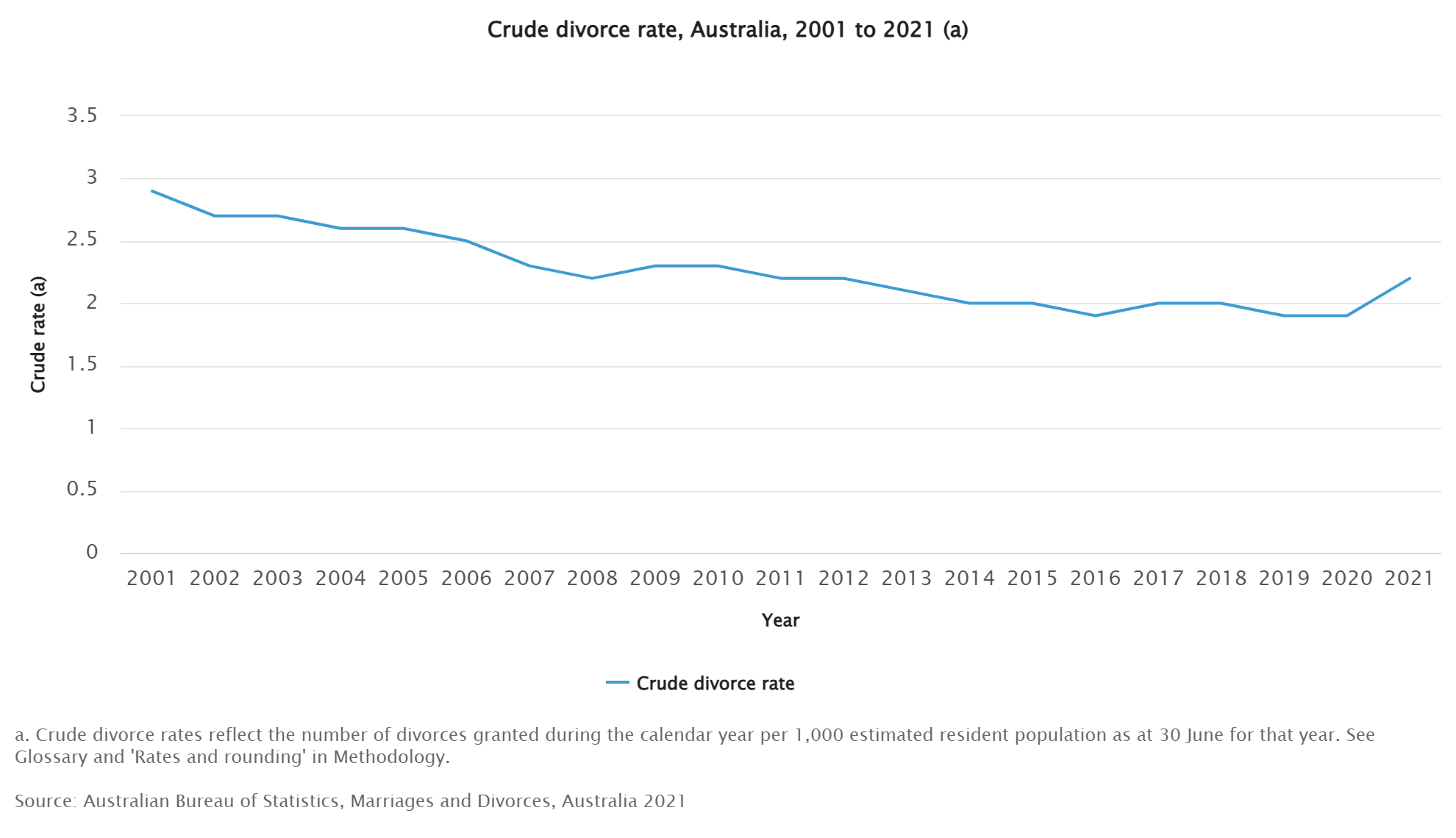
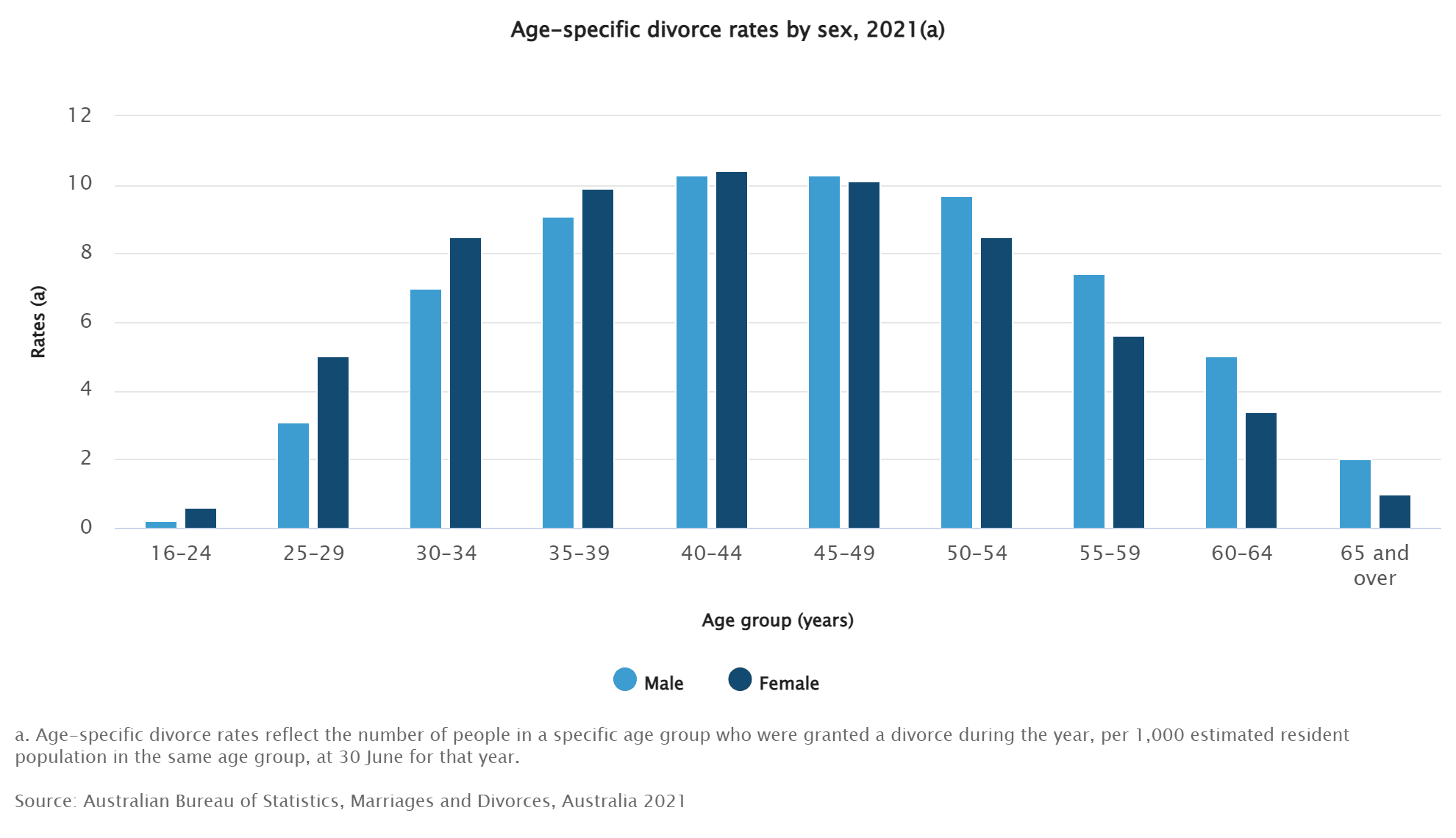
Trend 5: The number of divorces for straight couples is increasing
Interestingly the number of divorces for straight couples has jumped by more than 6700 in one year, 2021, compared with the previous year and the three years before that.
In fact, we have to go back two decades to the start of the century to see similarly high divorce numbers for straight couples.
One explanation for the high number of divorces of straight couples in 2021 may be the effect of some states and territories being locked down for such a long time in 2020.
Some relationships simply not survive the pressures of being with each other 24×7 as many were forced to live and work together for the first time in their marriage.
Trend 6: Approximately half of divorces involve children
The number of divorces involving children has been steady for the past five (5) years, hovering around 47% to 48%.
The number of children involved in divorces is approximately two.
Making sure the children are safe and informed at a time of separation and divorce is paramount. There are some helpful resources available, such as this one about talking to children about separation.
Statistics of LGBTIQ+ marriages
Until December 2017, it was illegal for LGBTIQ+ people to get married in Australia. And so, the ABS had no data on marriages in which one or both parties to the marriage were LGBTIQ+.
And, it must be noted that, although the ABS collects data on all marriages, including those where one or both parties to the marriage tick the ‘non-binary’ box rather than the F box or the M box on the Notice of Intended Marriage, the ABS only reports on those LGBTIQ+ marriages that are between two women or two men.
Marriages involving anyone who is non-binary (i.e. not m-m or f-f) are not reported on by the ABS. Hence, in this blog, the ABS statistics involving LGBTIQ+ marriages are inaccurate – although they capture m-m and f-f marriages, they do not include the marriages of all LGBTIQ+ people.
Trend 7: LGBTIQ+ marriage numbers boomed and have now settled down at much lower levels
Before marriage equality became law in Australia, there was a flurry of predictions in the media that many billions would flow into the Australian economy as many thousands of LGBTIQ+ couples rushed to get married.

Of course, those predictions were based on stereotypical assumptions and were made by straight journalists and commentators with low queer literacy and little knowledge or understanding of LGBTIQ+ culture or people.
No such ‘pink rush’ happened. In fact, in the first year, the number of LGBTIQ+ weddings that actually took place was between 1/3 and ¼ of those predicted. And many LGBTIQ+ weddings were small, intimate gatherings.
Some LGBTIQ+ couples were in a hurry to get married, because they were now elderly or iill and aware of the little time they had left to live as a married couple and they wanted to maximise that.
Others, however, wanted to take their time to plan their wedding and get used to what this thing called marriage (which they’d been prevented by law from entering into) is about.

Hence, the statistics show a bit of a boom in the year after marriage equality became law in Australia, and then the slowing down of the boom into a more stable trend where the numbers are fewer than half the ones in the initial boom years.
Trend 8: More LGBTIQ+ women get married than LGBTIQ+ men
A trend that has been obvious since marriage equality became law in Australia is that more LGBTIQ+ women get married than LGBTIQ+ men.
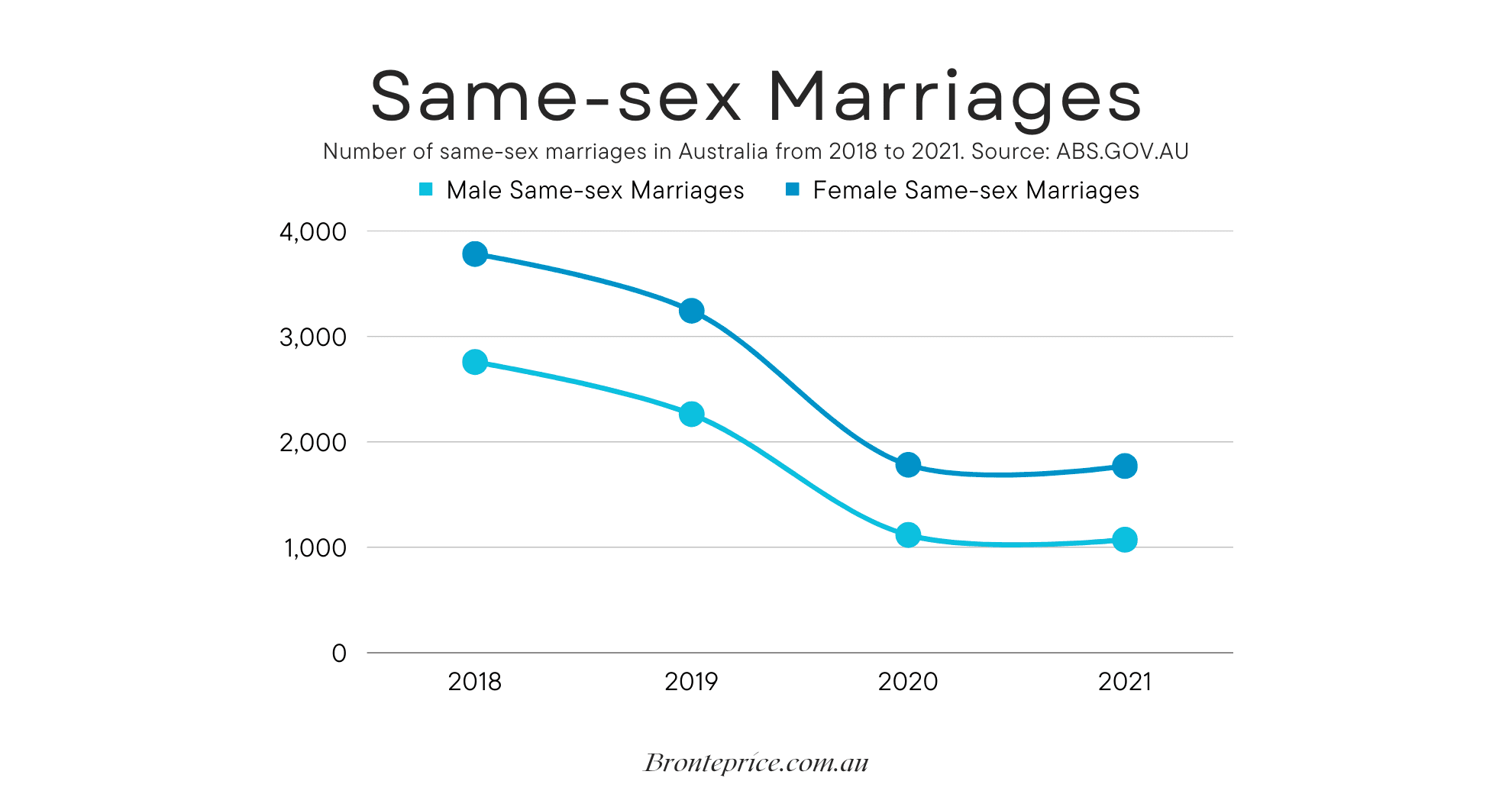
For the first two years after they were allowed to, approximately 1/3 more LGBTIQ+ women got married than LGBTIQ+ men.
For the most recent two years, although this gap has closed somewhat, it is still present.
There are several potential reasons for this:
1. Some LGBTIQ+ women may wish to be a princess for a day, like their straight counter-parts.
2. Some LGBTIQ+ women may wish to begin forming a family, and they see marriage as the basis for this.
3. LGBTIQ+ men are in less of a hurry to get married, and will eventually marry an LGBTIQ+ man they love, but their timeline may be less pressured and more flexible than that of LGBTIQ+ women.
Do you need help to plan your wedding in Melbourne?
Trend 9: The proportion of ‘same-sex’ couples getting married is very low
The proportion of marriages that were ‘same-sex’ in 2021 was just over 3%, compared with 5.5% in the first year of marriage equality. Both of these proportions are very low.
There are a number of reasons for this:
1. Given the fact that numerous governments continued to outlaw marriage equality from 2004-2017, and that in 2017 the government of the day asked all eligible Australians to take in a postal vote on the right of LGBTIQ+ couples to get married, many LGBTIQ+ couples have grown tired of the constant struggle for equal rights and have grown cynical of this thing called ‘marriage’.
2. Some LGBTIQ+ couples simply wanted the right to get married – they saw marriage inequality something that was intrinsically wrong.
They joined the struggle to gain this basic human right that was denied to no other part of society. But they had no intention of getting married. It was always about the right to get married rather than being driven by wanting to get married.
3. Many LGBTIQ+ couples look at the statistics of straight marriages and seriously ask themselves “is this what we want?” Given that half of straight marriages end in divorce after around 8 years, many LGBTIQ+ couples doubt it’s worth it for themselves.
4. Lots of LGBTIQ+ couples believe that the wedding industry is a licence to print money. The instant you let a hotel or venue know you’d like to hold an ‘event’ there and that event is a wedding, suddenly the prices sky-rocket. LGBTIQ+ couples are, by and large, opting for smaller, legals-only weddings that cost the bare minimum. Rather than invite 150 of their nearest and dearest, they will share some great food and fine wine with a small number of close friends to celebrate tying the knot.
Many LGBTIQ+ couples, especially older ones, will openly say they only want the ‘piece of paper’ that legalises their marriage. They will have taken time to consider if it’s worth them getting married, and then have a simple ceremony without the trappings of a typical straight wedding.
Trend 10: Same-sex couples are older than straight couples, when they marry

Same-sex male couples and female couples are typically in their mid-30s when they marry. That’s older than straight couples who are typically in their mid-late 30s (men) or in their mid 30s (women).
Often same sex couples have been together for a substantial time and have waited for marriage equality to occur before even discussing whether or not to get married. And from there, it’s the other discussions that need to take place (what sort of wedding will we have? Who will we invite? etc) that then takes the time to plan.
And we mustn’t forget that same-sex couples have not been educated about marriage and weddings – many never thought it would be possible for them to marry the person they loved, in the course of their life on earth.
LGBTIQ+ couples have not had any LGBTIQ+ role models to follow, when it comes to weddings. When it came to planning their wedding, they’ve literally had to make it up as they go – or follow what they know – ie straight weddings.
Straight couples, on the other hand, are much better versed in weddings and marriage. The template has been clearly laid out for them their whole lives – their parents, aunts and uncles and grandparents, as well as every married couple in society has been straight.
Every wedding and the associated rituals and traditions have been straight.
Straight couples have had real life and media-based role models. Until relatively recently, TV and film only featured marriages that were between straight people or straight characters.
The Author
Bronte Price is a registered marriage celebrant. Whilst he marries anyone in love, as a gay man he particularly caters to LGBTIQ+ couples. Prior to becoming a marriage celebrant, Bronte was Assistant Director, Data Analytics and Digitisation at the Victorian Ombudsman. Bronte conducts LGBTIQ+ inclusion training for workplaces, including for the wedding industry, through The Equality Network.
Get the latest wedding ceremony news, advice & tips
Sent straight to your email each month



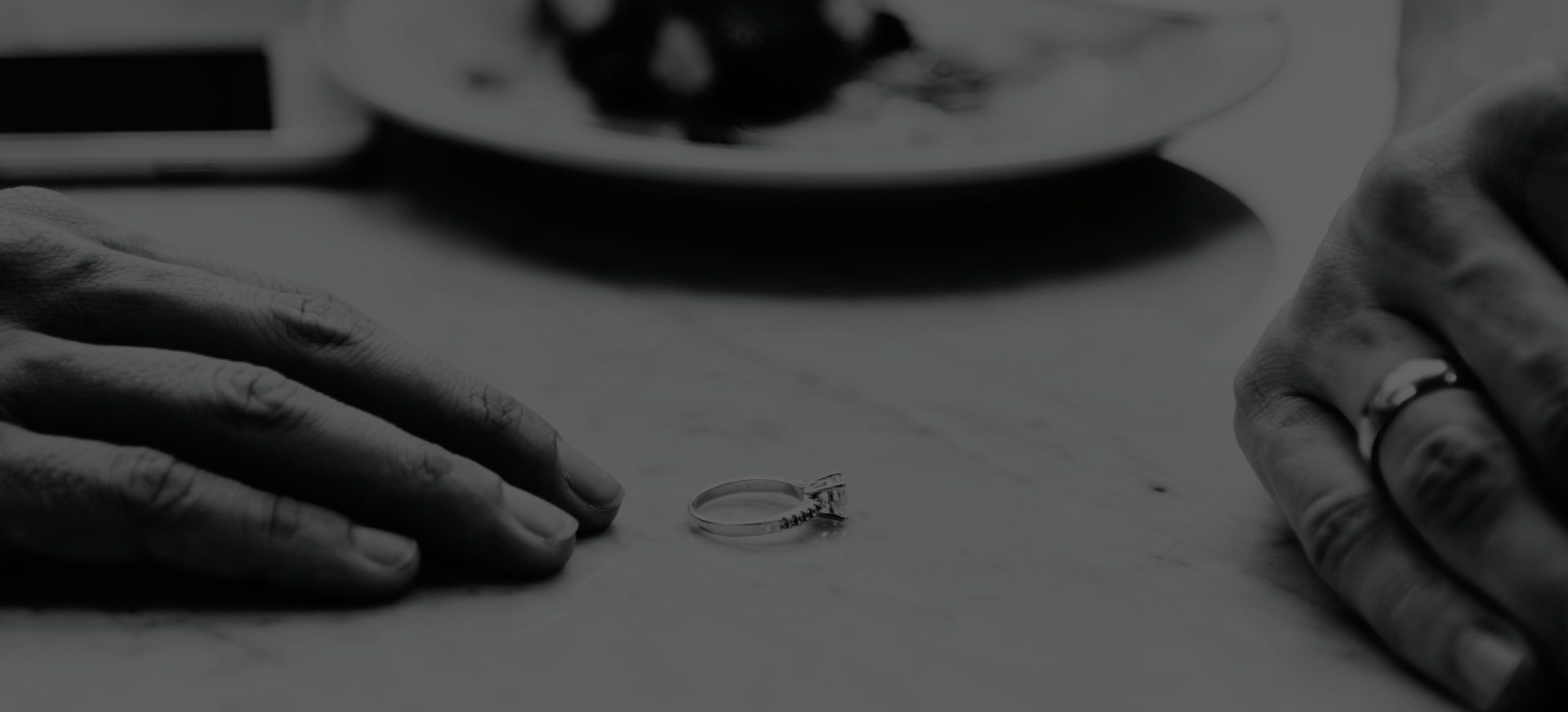
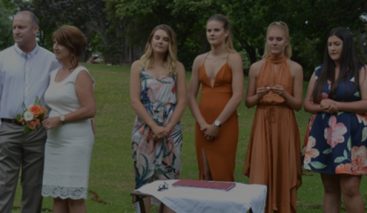



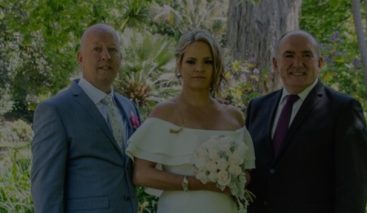
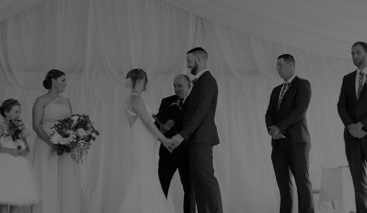

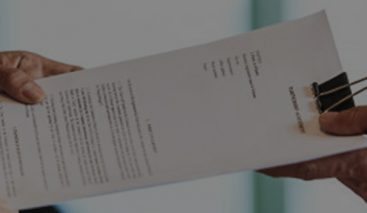
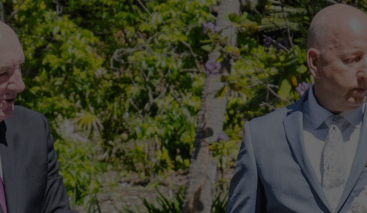


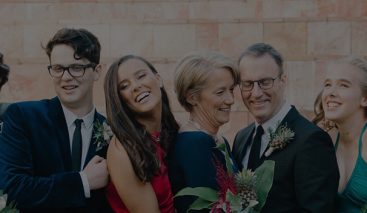


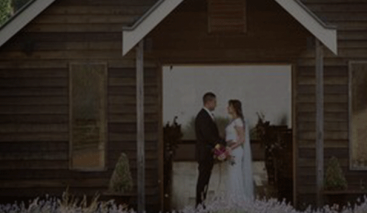





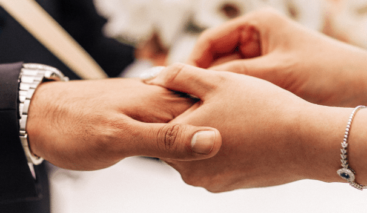






Sorry, the comment form is closed at this time.